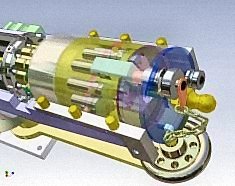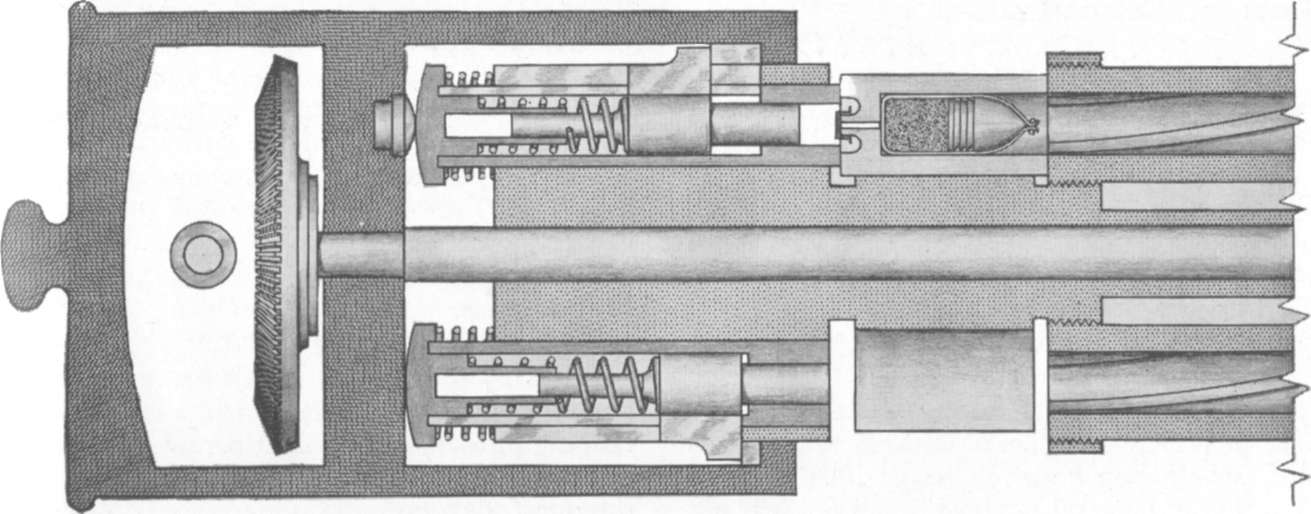Gatling guns under construction. I am currently working on a Model 1877 and a Model 1879. Neither gun as been spoken for as of 8/03/20. If interested in either gun please contact me at 937-232-8951. Model 1879 Gatling under construction. Model 1874 Gatling gun - Sold. Model 1897 Gatling gun - Sold. Custom made by Karl J. Furr (with correspondence and instruction manual included). Steel, brass and wood construction. Adjustable for elevation and windage (T&E). Mounted on a carriage with 18' wheels and a trail. 10 steel in-the-white barrels with a length of 12-5/8' each. Comes with a Broadwell drum holding approx. Brass Castings to make the Full Scale Colt Gatling Gun. One set of brass castings for the ten barrel Colt 1874 or 1883 Gatling Gun with the elevating and automatic traversing mechanisms. These castings were made some years ago in molds formed using original Colt positive patterns. The Model 1876 Gatling Gun was built at a significant period of U.S. Government campaigns against hostiles in the West. It was a featured display at the 1876 Centennial Exhibition, at which Dr. Gatling received a medal for his weapon. This is the first time ever that this Gatling Gun has come to auction.

Thanks to a friendly collector, we had the chance to take out one of the new, gorgeous reproduction 1877 Gatling guns being sold by Colt. It’s a near-exact replica, with the added feature of being able to crank backwards to safely clear any loaded cartridges out of the action. Being a Bulldog model, it has 5 short barrels (18.25″) chambered for.45-70, enclosed in a full brass jacket to keep the action clean. Colt claims it will do 800 rounds/minute, but we got it going a bit faster Thanks to an interesting quirk of US gun laws, the Gatling is not considered a machine gun – so anyone who can possess a bolt action rifle can own and shoot one of these.
The crank handle is considered a trigger, and each partial turn fires a single round. Since a single discrete motion doesn’t fire multiple rounds, it’s not subject to the registration and transfer tax of a machine gun under the NFA. As I mentioned at the end of the video, the fellow who owns this gun has a second one for sale at a pretty reasonable price (though keep in mind that new, one of these guns will set you back the equivalent of a pretty nice new car). It only saw a few hundred rounds’ use, and has been thoroughly checked over by one of the original builders.
The RGG looks like a Gatling gun, but the D&E is a much more accurate model, much closer in scale than the RGG, but a bit more difficult to build. D&E has updated and redrawn the plans since my purchase and includes a pretty good set of build instructions.
If you are interested, please, and I can put you in touch with the seller. It is not by some legal quirk, but Gatling technically really isn’t a machine gun, which is these days defined as an firearm capable of firing fully-automatically. Gatling is ‘machine’ but not ‘automatic’ at all, each shot out of a Gatling is initiated separately, and it is hand-operated. It’s like a giant pepperbox revolver, only you have a crank to turn it, instead of a DAO trigger, and each barrel has it’s own lock. Nordenfeldts, Palmcranzes, Gardners, Raffye or other volley guns are not considered machine guns as well.
And keep them that way, because they’re the only machine gun look-alikes readily available to most gun enthusiasts, even where gun laws are in fact anti-gun laws (don’t they all?). Unless I’ve overlooked something, this looks like a patent for a modification to the basic Gatling to turn it into a gas-operated, self-loading fully-automatic gun. I believe General Electric, among others, have in recent years produced prototype gas-operated Gatlings in various calibers as lighter-weight, self-contained / self-powered alternatives to the standard electrically-driven guns, although they have not gained wider acceptance in the U.S.
And the West in general. The Soviets, on the other hand, have taken this concept to a new level and perfected it with weapons such as the GSh-6-23 and GSh-6-30 rotary cannons for assorted applications ranging from ground-attack aircraft to naval CIWS. Prezentaciya znachenie zhivotnih v prirode i zhizni cheloveka 5 klass 2. One thing I have noticed about Soviet ( and Russian ) automatic arms designers is a very distinct preference for gas-powered operation, and with the massive amount of experience and innovation they have in this area of gun operating systems, it comes as no surprise.

Although Dr. Richard Gatling’s early hand-cranked “battery guns” had been introduced as far back as 1862, for the first 15 years of their existence they were bulky and used a series of unshielded barrels to produce their fire. Round were fed loosely into a hopper and the weapon could produce a (theoretical) rate of fire of about 600 rounds per minute, although due to jams and gas issues, it was typically closer to 200 and often could not be maintained.
Early Gatling guns, such as this .58-caliber RF 1862 model, with a half-dozen 33-inch barrels, had a rate of fire of 600 rpm, an overall length of 64-inches and a weight, with carriage and limber, of about 630 pounds, unloaded. (Photo: Springfield Armory National Historic Site)

By 1866, Colt took over making Dr. Gatling’s guns and won the first large U.S. Army contract for the devices, one they were eager to keep by introducing upgraded generations. By 1873-ish, the caliber had switched to .45-70 Government and short-barreled “Camel” guns were being produced, which were much more maneuverable.
In 1877, Colt introduced a new model that enclosed not only the barrels but also the breech section in a bronze housing covered by a front plate through which the muzzles protruded. Further, the crank could be rotated to a more ergonomic rear position and, through use of a 40-round Bruce vertical feed mechanism which could be topped off, the rate of fire really jumped to well over 1,000 rounds per minute as the gun in a 10-barreled format, fired 10 rounds with each turn of the crank. Best yet, the smaller 5-barreled gun, when used on a tripod, only weighed 90-pounds.
Gatling Gun Plans For Sale
In an Army test of a prototype gun, one of the Bulldogs fired 1,000 rounds in 79 seconds— which is amazing even by today’s standards– and scored 996 hits on target at a range of 500 yards. Uncle Sam bought 17 Bulldogs for the Army as well as others for the Navy and the model proved popular in overseas sales as well.
An M1883 Colt Gatling gun in .45-70 with a 104-round Accles magazine
While more modern autoloading machine guns replaced Gatlings in U.S. service, some were still seeing combat in China and the Philippines in the early 1900s.

The M1893 Gatling, the first chambered in .30-40 Krag. This wonder, fitted with 10 31-inch octagon barrels, could let those big buffalo-killer sized rounds rip at 525 rounds per minute, which would produce a giant billow of burnt black powder in the process. Weighing in at 200-pounds (sans bipod) this thing was a beast to run but had all the bells and whistles of a modern Gatling design including the Murphy Stop and the Bruce Feed.
9th U.S. Infantry Gatling gun detachment in the court of the Forbidden City, Peking, China 1900 Boxer rebellion LC-USZ62-137103 1874
Gatling guns trained on the Filipinos, near Manila, Philippine Islands Nov 25 1899 LC-USZ62-136148 1893 models
1874 Gatling Gun Blueprints Kit
Further, Gatlings were only fully retired by the U.S. Army after 1914, not a bad run considering only about 500~ in 20 different marks were acquired between 1866 and 1904.
U.S. Army/Navy Colt Gatlings acquired, model, caliber and number:
See Full List On Fallout.fandom.com
M1866 .50-70 (50 Army)
M1871-.50-70 (10 Army)
M1874 Camel .45-70 (56 Army)
M1875 Long .45-70 (44 Army)
M1875 Camel.45-70 (4 Army)
M1875 Navy .45-70 (10 Navy)
M1876 Long .45-70 (19 Navy)
M1877 Bulldog .45-70 (17 Army)
M1879 .45-70 (32 Army)
M1881 .45-70 (27 Army)
M1883 .45-70 (40 Army)
M1885 .45-70 (21 Army)
M1886 .45-70 (20 Army)
M1887 .45-70 (20 Army)
M1889 .45-70 (18 Army)
M1891 .45-70 (17 Army)
M1892 .45-70 (18 Army)
M1893 .30-40 Krag (18 Army).
M1895 .30-40 (84 Army).
M1903 .30-06 Spfd (21)
In 1907, about 175 older Gatlings (M1895/1893/1892/1891/1889/1887/1886 models) were rechambered for .30-06.
The below unit return, from the 136th Company (Mine), U.S. Army Coastal Artillery, stationed at Fort Hancock, New Jersey, details they were still practicing with their .30-caliber Gatlings as late as October 1914. It would have been interesting to imagine them repelling an assault by the Kaiser’s infantrymen with such gear.